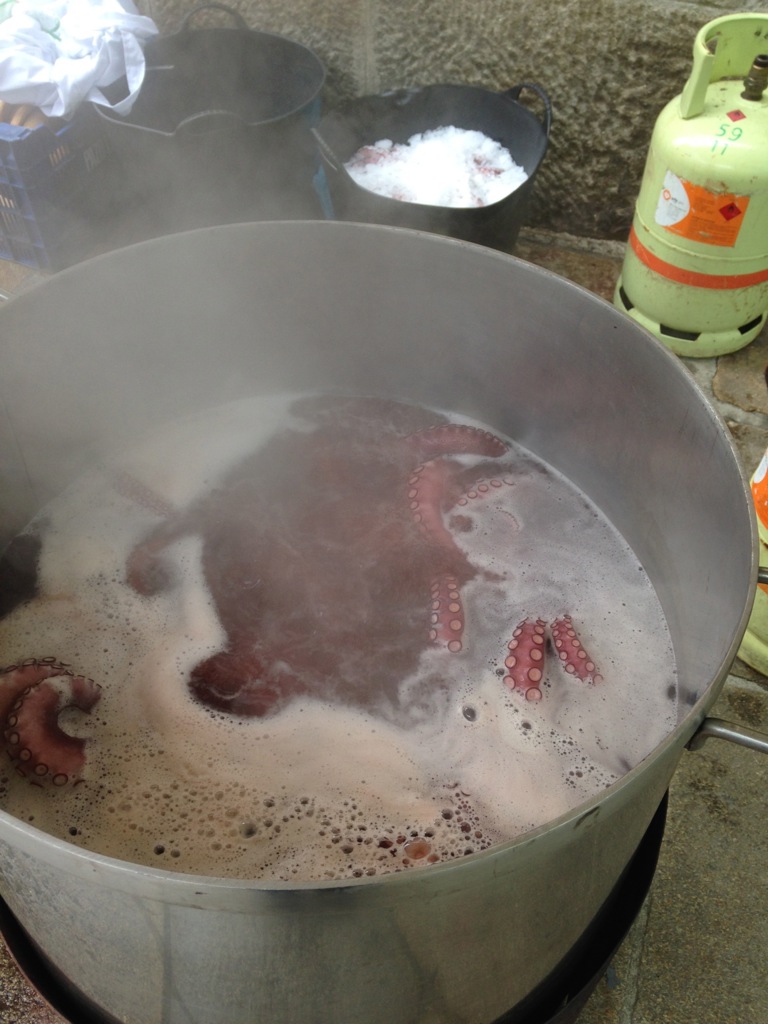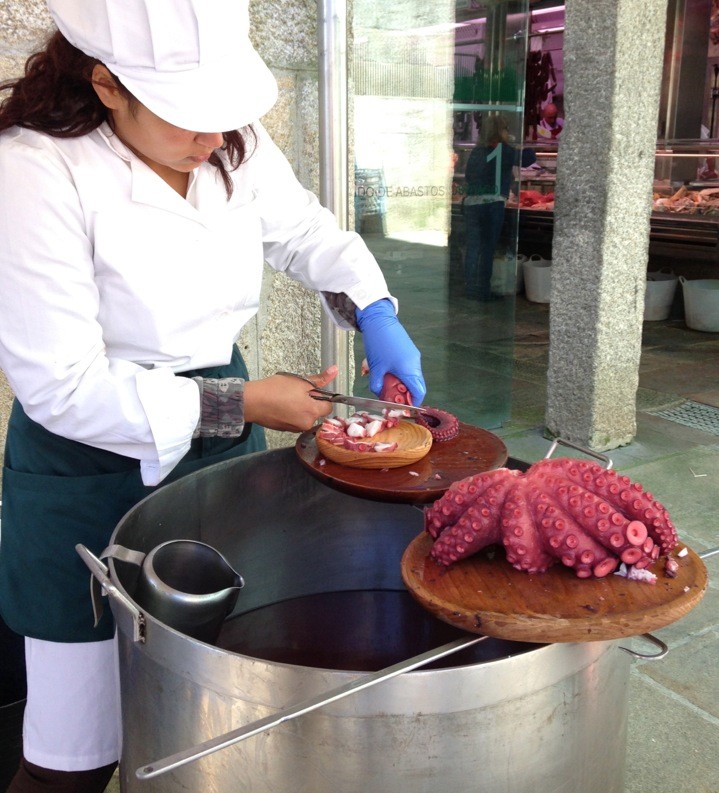
The Eight Tentacles of Galicean Octopus: Polbo á Feira
Tentale #1: Where do we eat octopus?
Galicia.
The Galicans are mad for octopus and other Spaniards travel to Spain’s northwest corner just to eat the many-armed mollusk the Galician way. Spaniards have a special name to honor the Galecian perparation: pulpo gallego.
We arrive in Santiago de Compostela, Galicia, a bit after 9 A.M., early by Spanish standards. Hungry after an all night bus ride we head to the market in the old city, the only place that has been humming since dawn.
Tentacle #2: What reasons do we need to eat octopus?
You could choose from any of these reasons:
- It’s spring in Galicia.
- Contrary to the expected climate, the sun is blazing down, warming the ancient stones and the hearts of all the nearby Spaniards.
- Palm Sunday is just a few days away, and then the holiday week of Easter begins.
Trick question!
We need no reasons to eat octopus. Or perhaps more accurately, from the Galician perspective, every reason is a good reason to eat octopus.
Tentacle #3: Who cooks octopus?
The city feels ripe for festivities; everyone anticipates a fair. Fresh tarts dusted with powdered sugar in the shape of a stylized cross pack the bakeries. Special palm arrangements and olive branches are on sale for Palm Sunday. Chefs are setting up in unused corners of the market to give demonstrations and sell tasty treats.

The father figure of our octopus cooking team. In his hand is the olive oil can and the paprika shakers are nearby.
One pair of cooks we can watch from our coffee and croissant is a father-daughter team. They have industrial-sized cauldrons and start heating the first with a turbojet of propane from a huge burner set underneath. The burner makes a immense roar and Dad fiddles with it for nearly half an hour before turning it down and leaving it in charge of his daughter. In fifteen minutes he’s back and angry as a sea captain run aground.
“Girl! You’ve let the flame go out!”
The lecture is a shame for her but helpful for us because we learn the octopus must undergo an extended boiling.
Anyone can cook an octopus. Experience helps.
They relight the burner–muy rapidamente–because the lunch rush is near at hand. What we don’t yet understand is that they are going to be the most popular lunchtime attraction.
Tentacle #4: How is the octopus cooked?
The most common preparation is polbo á feira (That’s Galician, meaning “fair-style octopus.”), which seems a most appropriate dish as we watch the steam rise from the cauldrons at the pre-Semana Santa market.
Yet as there are a thousand cooks in Galicia, so there are a thousand ways to cook octopus, even if all thousand cooks use a pot of boiling water.
Our father-daugther team salted their water. We think that was to get their water boiling faster more than anything. They had a sizeable hook they used to stir the pots and lift octopi from place to place.

A steaming cauldron filled with octopi. The propane tanks are in the background, as is a bucket of salt.
Our research—watching people cook and reading on line in several languages—suggests that a chefly arroach involves:
- Dipping the arms in the boiling water to stiffen the skin and curl the tentacle tips.
- Dropping the octopus into the boil for about 20 minutes per kilogram
- Letting the octopus finish in near-bboiling water for about 20 mintes
Of course, the experienced cooks adjust that for conditions like the size and condition of the octopus. The short story?
Boil it.
The local octopi go from a purplish grey color to a rich, rosy red-purple. They get more reddish if they are refrigerated after the first cooking, which restaurants sometimes do.
Tentacle #5: How do you plate octopus?
For polbo á feira there are a few simple rules to follow.
- The head is almost never served.
- Serve on a rustic wooden plate (Yes, nearly every restaurant in Galicia has a set of wooden plates which they probably only use for polbo á feira.)
- Grab a tentacle and snip half-inch thick rounds with a pair of (big) scissors.
- Sprinkle some great olive oil and a little of the cooking water atop the rounds.
- Dust the top with paprika and a course grained salt.
Our market-fair chefs in Santiago de Compostela used a hot paprika, which added a zing of complexity to an otherwise simple dish. We’ve also had it with sweet and smoked paprika. Our personal leaning is to the hotter spicing.

Plating the octopus. Small wooden plates are used to serve, and large wooden platters hold the octopus. The hooks used by the cooks are holding up the large platter with the cooked octopus. Big scissors!
Also, many people will serve crusty bread alongside the seafood, and diners use it to sop up the olive oil and cooking water. Our market chefs just turned out superb octopi. If you wanted bread, you could find that at other market stalls.
A slightly up-scale version of this dish serves the octopi atop rounds of boiled potato. That’s tasty, to be sure, and Galician, but it isn’t pure polbo á feira.
Tentacle #6: How do you eat octopus?
You will get a toothpick.
It’s a fair! Don’t expect cutlery. You shouldn’t need cutlery.
Skewer the rounds with your toothpick. Pop them in your mouth. Enjoy.
At our ‘fair’ on the hard stones of Santiago’s old city, the cooks were in a hurry: we got a half-dozen toothpicks to share.
Tentacle #7: How do you know you’re having awesome octopus?
First, if the rubber-tire octopus served by cheap sushi restaurants has traumatized you, please don’t worry. You are in the gentle, safe hands of Galicans.
The outer part of the round—including the skin, the sucker, and the flesh between the skin and the main muscle—has a texture that is similar to not-yet-crispy bacon fat. Luxurious!
The inner, muscular part of the round is the more toothsome, with a chew that offers a bit more resistance than a scallop, but is dashingly hard to describe, because the octopus flesh has no significant grain to it.
The whole package has a mouth-melting quality, like the perfect bite of aged fillet mignon.
The flavor is rich on the tongue, but not heavy: oceanic but not briny.
Tentacle #8: What do you drink with your octopus?
While Alison procured our plate of octopi, I procured the drinks. A tiny wine bar was open in our little corner of Galicia. But which of the two-dozen local wines was the right one? What about beer?

The white wine we enjoyed with Galician octopus. The albariño grape is grown in Galicia and northern Portugal. The wines often have the tiniest bit of fizz and have sublime fruits and mineral characters. Rias Biaxas is a small growing region in Galicia with international distribution.
I wasn’t in the know when I ordered, and I wasn’t sure what to expect, so—having some scientific bones in my body—I chose both a red and a white as an experiment.
What I know now is: there is legitimate disagreement about what to drink with your octopus, even among purist Galicians.
I did right. Here are two good answers:
A young red wine.
A full-bodied white wine with some mineral.

The red wine that accompanied our first plate of octopus in Galicia. The grape is mencia, which is grown only in northwest Spain. This bottle comes from Ribeira Sacra, the largest growing region in Galicia. If you find some, expect an easy-drinking, light bodied purple-red with lots of darker fruit flavors and a some herb quality.
The red brought out the meaty quality of our octuopus, while the white brought it back to the sea. The red played more games with the paprika and salt, while the white’s clearer fruit flavors made the seafood more playful.
That’s an amazing thing about polbo á feira. You can’t go wrong in chosing a drink to accompany it.
Thoroughly enjoying Spain’s Atlantic coast,
Chris


You’ve just made octopi sound appealing to me! This is huuuge.
Andy,
Shall we plan a massive mollusk munching when we return to the Portland area?
We’re game to try cooking some!
Your Galicians in training,
Chris & Alison
Am aflat aceasta pagina, dupa ce am cautat despre The Eight Tentacles of Galicean Octopus:
Polbo á Feira pe Google. Se pare ca informatia dvs e foarte valoroasa, mai ales ca am mai gasit aici si
despre ora, ora exacta, lucruri interesante si folositoare.
Mult succes in continuare!